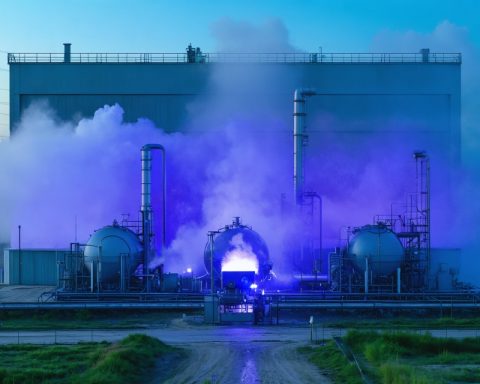- Hydrogen technology is transforming the aviation industry, potentially enabling airplanes to emit only water vapor instead of carbon emissions.
- Hydrogen is seen as a significant solution to reducing the sector’s environmental impact, aligning with global carbon neutrality goals.
- Airbus plans to launch the first commercial hydrogen-powered aircraft by 2035, showcasing innovative designs and quiet engines.
- Challenges in hydrogen production, storage, and transportation persist, requiring substantial infrastructure investment and innovation.
- European nations are leading the charge with significant investments in hydrogen technologies and infrastructure.
- With global support, clean hydrogen promises a sustainable future for aviation, reminiscent of the pioneering spirit of early flight.
The aviation industry stands on the brink of a transformative era, powered by the potential of clean hydrogen. Picture a future where airplanes soar silently across the sky, leaving only a trail of water vapor behind. This vision is no longer science fiction; it is fast becoming reality.
Recent breakthroughs in hydrogen technology have ignited a spark of hope for a sector long criticized for its environmental footprint. By replacing conventional jet fuels with hydrogen, airplanes can dramatically cut emissions, offering a cleaner, more sustainable way to travel. Around the world, innovators are racing to harness this power, crafting engines that splinter water molecules and release hydrogen’s boundless energy.
The potential impact is staggering. Unlike traditional fuels, which spew carbon dioxide, hydrogen fuel emits only water when consumed, drastically reducing the greenhouse gases contributing to climate change. As nations ramp up efforts to meet ambitious carbon neutrality goals, clean hydrogen emerges as a critical player.
Airbus, a leader in aviation technology, has unveiled plans for the first commercial hydrogen-powered aircraft by 2035. These futuristic designs feature sleek outlines and whisper-quiet engines, signaling a new dawn for air travel. But clean hydrogen’s promise extends beyond mere design; it offers the aviation industry an opportunity to reinvent itself, securing it a role in a sustainable future.
However, challenges remain. Producing, storing, and transporting hydrogen demands sophisticated infrastructure and significant investment. Yet, with global momentum and institutional support, the tides are shifting. European countries, for instance, are investing billions in hydrogen infrastructure, crafting a network that will fuel both planes and progress.
The stakes are high, but the rewards are higher. Clean hydrogen holds the key to unlocking a future where blue skies are unmarred by pollution, where travel no longer costs the earth. This pioneering journey mirrors the excitement of early flight, where innovation dared to defy gravity.
Join the clean hydrogen revolution today, and witness the transformation redefine our skies and our future. The horizon has never looked this blue.
How Clean Hydrogen is Revolutionizing the Aviation Sector
In-Depth Exploration of Clean Hydrogen in Aviation
As the world seeks sustainable solutions, clean hydrogen emerges as a beacon of hope for the aviation industry. While the dream of zero-emission flights is tantalizing, realizing this vision involves navigating numerous complexities. Below, we delve deeper into the transformative potential, challenges, and future of hydrogen-powered aviation.
Hydrogen’s Role in Aviation
Hydrogen, when used as fuel, has the potential to dramatically reduce the carbon footprint of aviation. Here’s why:
1. Zero Direct Emissions: Unlike conventional jet fuels, burning hydrogen produces only water vapor, eliminating carbon dioxide emissions and other pollutants.
2. High Energy Content: Hydrogen boasts an energy density nearly three times that of traditional jet fuel by weight, albeit significantly less by volume, necessitating innovative storage solutions.
3. Abundance: As the most abundant element in the universe, hydrogen offers a virtually limitless supply when captured sustainably.
Challenges to Overcome
1. Production: While hydrogen is abundant, separating it from compounds like water typically requires energy. ‘Green hydrogen,’ produced using renewable energy sources, offers a clean solution but comes with a higher cost.
2. Storage and Transport: Hydrogen must be stored at high pressures or low temperatures, which necessitates significant infrastructure investment. Innovations in cryogenic tanks and pipeline technology could mitigate these challenges.
3. Infrastructure Development: Building a global hydrogen refueling infrastructure is capital-intensive and requires coordination across international borders.
For more on energy innovations, visit Airbus.
Industry Trends and Predictions
1. Increasing Investments: Companies and governments are investing billions to develop hydrogen infrastructure. For instance, the European Union has allocated substantial funds towards hydrogen projects as part of its Green Deal.
2. Technological Advancements: Developments in hydrogen combustion engines and fuel cells are accelerating, with major players like Airbus targeting operational hydrogen aircraft by 2035.
3. Policy Support: With growing regulatory pressure to reduce emissions, policy frameworks are increasingly supporting cleaner aviation fuels.
Potential Impacts and Benefits
– Environmental Impact: Hydrogen can potentially reduce aviation’s carbon emissions by over 50%, significantly contributing to global climate targets.
– Economic Opportunities: As the technology matures, new industries centered around hydrogen production, storage, and distribution are expected to emerge, creating jobs and boosting economies.
Real-World Use Cases
– Demonstrator Projects: Several hydrogen-powered small aircraft prototypes are already in testing phases, providing valuable data for scaling up to commercial airliners.
– Airport Infrastructure Trials: Airports in Europe and the Middle East are piloting hydrogen refueling stations, setting the precedent for global adoption.
Actionable Recommendations
– Invest in Green Hydrogen: Encourage investment in green hydrogen technologies to lower production costs and facilitate widespread adoption.
– Support Policy Initiatives: Advocate for policies that provide financial incentives for research and development in hydrogen technologies.
– Engage with Industry Leaders: Follow and collaborate with aviation and energy companies actively researching hydrogen solutions.
Conclusion
Harnessing the potential of clean hydrogen could redefine the aviation landscape, paving the way for a future of sustainable air travel. With ongoing investment and innovation, hydrogen-powered aircraft could become a common sight by the mid-21st century, combining the best of technology and environmental stewardship. Stay informed and engaged in this emerging field to partake in its transformative journey toward a greener planet.


















